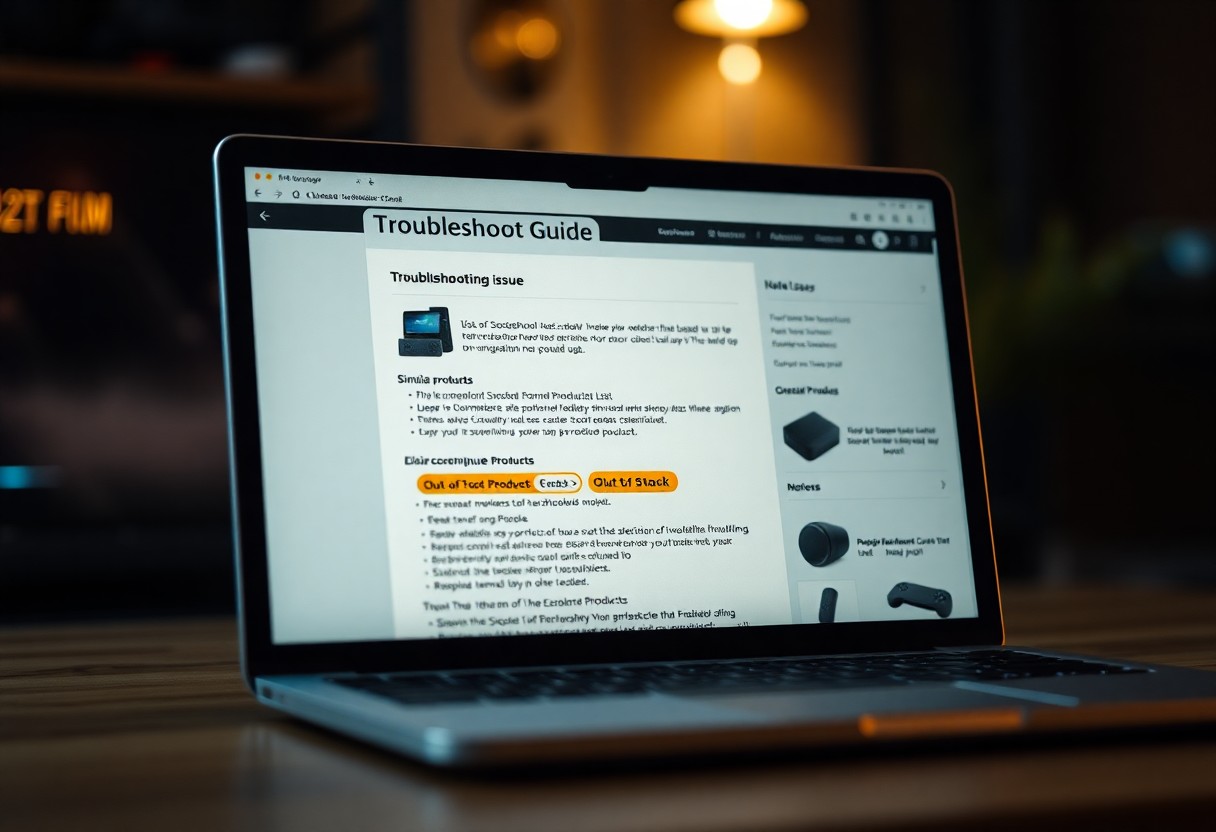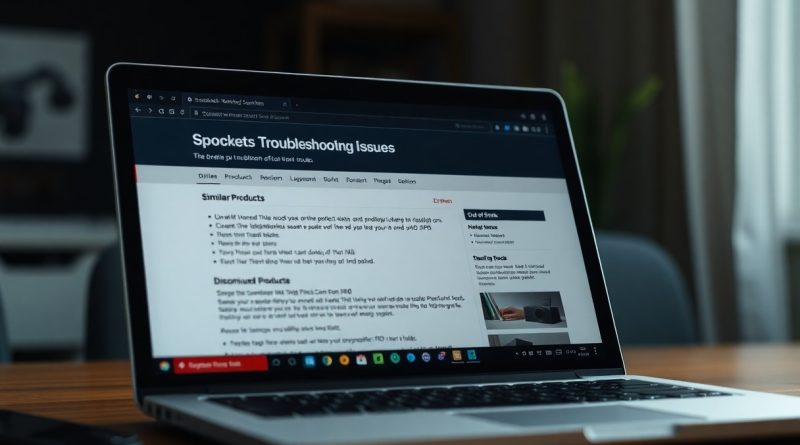Troubleshooting Common Spocket Issues – Out of Stock and Discontinued Products
It’s frustrating when you encounter Out of Stock or Product Not Found messages in your Import List. These notifications indicate that the product you want is no longer available from your chosen supplier. In this guide, you’ll learn how to effectively manage these situations by finding alternative suppliers or similar products to keep your business running smoothly. Understanding these steps will help you maintain a consistent inventory and enhance your customer satisfaction.
Understanding Out of Stock Messages
When you see an “Out of Stock” message, it means that the item you wish to purchase or resell is currently unavailable from the supplier. This can disrupt your plans and affect your inventory, making it important to understand how to react to these messages effectively.
Definition of Out of Stock
“Out of Stock” indicates that the retailer or supplier cannot provide the product for sale, usually due to insufficient inventory levels or a temporary pause in production. This status may be accompanied by an estimated restock date or simply state that the item is unavailable indefinitely.
Causes for Out of Stock Status
There are various reasons a product may be marked as “Out of Stock,” including high demand, supplier issues, production delays, or even seasonal fluctuations. The availability can be influenced by factors such as manufacturing capacity and logistical constraints, impacting your ability to source the product.
High demand often leads to products flying off the shelves faster than expected, leaving suppliers scrambling to restock. For instance, during holiday seasons, certain items may sell out rapidly due to increased consumer interest. Additionally, unexpected *supplier issues,* including shipping delays or production halts, can contribute to an item becoming unavailable. Keeping an eye on your suppliers’ inventory levels and sales patterns can help you anticipate potential stock shortages, allowing you to react promptly by finding alternatives or adjusting your import list accordingly.
Identifying Discontinued Products
To effectively manage your inventory, recognizing discontinued products is imperative. You can identify these items by monitoring your Spocket Import List for messages indicating they are no longer available. Regularly check for updates and consider joining the Spocket community to stay informed about any changes affecting your catalog. For a detailed discussion, refer to My Spocket app is removing my products successfully on ….
Signs of Discontinued Products
When a product is discontinued, you may encounter messages such as “Out of Stock” or “Product Not Found” in your Import List. These alerts often signal that the supplier has removed the item from their inventory, which can disrupt your store’s offerings. It’s vital to stay proactive in monitoring these signals to avoid customer dissatisfaction.
Impact on Your Import List
Discontinued products can significantly affect your Import List, leading to potential gaps in inventory and increased customer complaints. When products are removed, you’ll need to adjust your list accordingly and consider finding replacements or alternatives promptly to maintain sales.
Beyond just losing a specific item, the impact of discontinued products can ripple through your entire business. If you have multiple items affected, it could necessitate a thorough review of your suppliers and their reliability. Additionally, inconsistent stock levels can harm your brand reputation, ultimately affecting your revenue. Actively seek out comparable products to minimize disruption and keep your store competitive.

Alternative Supplier Options
When faced with discontinued products or stock shortages, exploring alternative supplier options can help you maintain your inventory levels. By researching different suppliers, you can find similar products that meet your needs and keep your business running smoothly. This process may also uncover unique items, giving you a competitive edge in your market.
Finding New Suppliers
To find new suppliers, utilize online marketplaces, supplier directories, and social media platforms dedicated to your industry. Perform thorough searches using keywords related to your products, and don’t hesitate to reach out to networks within your niche for recommendations. Exploring trade shows and industry events can also connect you with potential suppliers.
Assessing Supplier Reliability
Once you’ve identified potential new suppliers, assessing their reliability is imperative. Check their reviews, ratings, and testimonials from other retailers to gauge their performance. Additionally, examining their shipping times, return policies, and communication responsiveness will provide insight into their reliability.
A reliable supplier will consistently deliver quality products on time, contributing positively to your business. Look for suppliers with a proven track record, such as those with excellent ratings on platforms like Trustpilot or industry-specific forums. Engaging with these suppliers directly can reveal their customer support capabilities and willingness to resolve issues, ensuring a trustworthy partnership that enhances your operational stability.

Similar Products to Consider
When faced with an ‘Out of Stock’ notification, exploring alternatives becomes crucial. Utilizing features like product filtering on Spocket can reveal comparable items that closely match your needs. Additionally, community discussions such as Spocket – product out of stock ? : r/dropship can provide user insights for viable substitutes.
Product Comparison Strategies
To effectively compare products, analyze key features and reviews. Create a straightforward comparison table to assess alternatives quickly:
| Feature | Product A | Product B |
|---|---|---|
| Price | $19.99 | $24.99 |
| Shipping Time | 5-7 days | 3-5 days |
| Customer Rating | 4.5/5 | 4.0/5 |
Evaluating Product Alternatives
Assessing product alternatives requires strategic thinking. Look beyond initial specifications, including supplier reliability, customer service ratings, and shipping policies. Consider user reviews emphasizing real-life experiences to gauge quality. Conduct thorough research, as minute differences in features can significantly impact your customers’ satisfaction and your overall sales.

Updating Your Import List
To maintain an efficient inventory, regularly updating your import list is crucial. This involves removing items that are no longer available and incorporating new selections that align with market demands. By doing this, you ensure that your offerings remain competitive and relevant, preventing potential lost sales due to unavailable products.
Removing Unavailable Products
When products display an ‘Out of Stock’ or ‘Product Not Found’ message, it’s vital to remove these items from your import list. Keeping unavailable products can lead to frustration for both you and your customers. Regularly auditing your list helps maintain accuracy and ensures a smooth purchasing experience.
Adding New Selections
Time spent on adding new selections to your import list can significantly increase your sales potential. Consider browsing through up-to-date supplier catalogs or trending products to discover items that resonate with your target audience. Implementing customer feedback can also guide you in selecting products that have a higher likelihood of converting.
Diving deeper into adding new selections, consider leveraging tools that analyze market trends and consumer preferences. By focusing on categories experiencing growth, like eco-friendly products or smart home devices, you can position your store as a destination for sought-after items. Keep an eye on social media trends and utilize platforms where your audience congregates to spot emerging products before they become mainstream. These strategies not only enhance your catalog but also cultivate a loyal customer base eager for the latest offerings.
Proactive Monitoring Techniques
To effectively manage your inventory and mitigate the impact of product unavailability, implement proactive monitoring techniques. This includes employing tools and strategies that help you stay informed about stock levels and identify potential issues before they disrupt your sales. By actively engaging with your import list and utilizing available resources, you can maintain a steady flow of products and ensure your customers remain satisfied with your offerings.
Setting Alerts for Stock Changes
Utilizing alerts for stock changes can significantly enhance your inventory management. Many platforms offer notification systems that inform you when stock levels fluctuate, allowing you to act swiftly. By configuring these alerts, you can stay ahead of potential shortages and make informed decisions about restocking or finding suitable alternatives.
Regularly Reviewing Your Import List
Conducting a regular review of your import list is necessary to identify items that may become unavailable. By routinely checking this list, you ensure that you are aware of any changes in the status of products, such as those marked as ‘Out of Stock’ or ‘Product Not Found’. This proactive approach enables you to minimize disruptions and consider alternatives in a timely manner.
During your review, focus on products that have had consistent availability and identify any that are frequently out of stock. Tracking patterns can provide insights into supplier reliability. Aim to adjust your inventory strategy based on these insights, promoting diversified suppliers for critical products and ensuring you quickly pivot to similar items when necessary. This process not only supports operational efficiency but also strengthens your overall supply chain resiliency.
Summing up
Conclusively, when you encounter “Out of Stock” or “Product Not Found” messages in your Import List, it indicates that the items are unavailable for purchase. To resolve this, you can search for alternative suppliers or similar products to maintain your inventory. It’s necessary to stay proactive by regularly checking your product availability. For additional guidance, visit Why am I unable to check out an order in my store? for more information on handling such issues effectively.
FAQ
Q: What does it mean when a product is listed as “Out of Stock”?
A: “Out of Stock” indicates that the supplier currently has no available inventory for that product. It may be restocked in the future, but there is no guarantee.
Q: How can I handle products that are marked as “Discontinued”?
A: When a product is “Discontinued,” it means that the supplier will no longer carry that item. You will need to search for alternative products or suppliers.
Q: What steps should I take if I receive a “Product Not Found” message?
A: A “Product Not Found” message means the product has been removed from the supplier’s catalog. Check for updated product listings from the supplier or explore similar items from different suppliers.
Q: How can I find alternative suppliers for an out-of-stock product?
A: You can search for similar products in your Import List and check various supplier catalogs. Utilize filters to find alternative options that match your product specs.
Q: Is it possible to set up alerts for product availability?
A: Many platforms offer alert features for product restock notifications. Enable notifications to get updates when products become available again.

